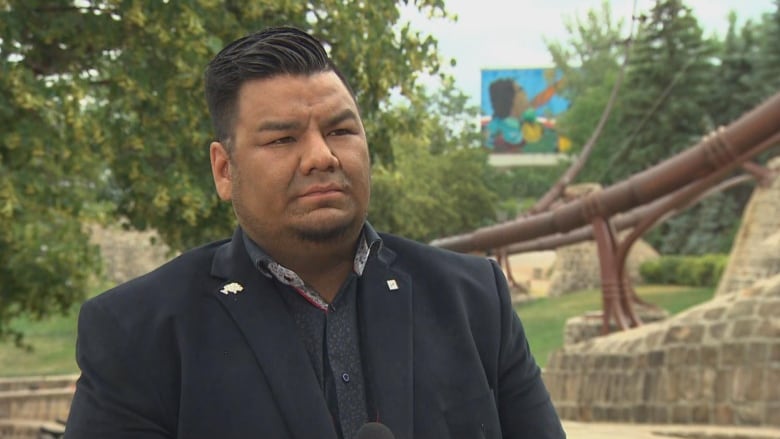A number of Indigenous people are calling on Premier Brian Pallister to educate himself on their history in the province, after he gave what they say is a distorted reframing of colonization earlier this week.

A First Nations leader is among those accusing Manitoba’s premier of offering a distorted reframing of the province’s history, omitting the displacement of Indigenous people and violence against them in what feels like “a punch in the gut.”
“It’s very disheartening, very disrespectful to Indigenous people,” said Leroy Constant, the interim grand chief of the Assembly of Manitoba Chiefs.
Constant is among a number of Indigenous people calling on Brian Pallister to educate himself on the history of colonization in the province, after the premier spoke publicly about the toppling of the statues of Queen Victoria and Queen Elizabeth on the Manitoba legislative grounds on Canada Day.
On Wednesday, Pallister admonished those involved in bringing the statues down and announced they will be restored.
“We need to respect our heritage just as we need to respect one another…. Not to find fault. Not to tear down, not to highlight every failure, but rather to realize that we’re a complex country as we are made up of complex people,” Pallister said at a Wednesday news conference.
“The people who came here to this country, before it was a country and since, didn’t come here to destroy anything. They came here to build. They came to build better.”
WATCH | ‘They didn’t come to destroy anything,’ premier says:

Manitoba Premier Brian Pallister addressed the toppling of two statues of British queens at Manitoba’s legislature on Canada Day. 2:47
That take on history doesn’t sit well with Constant, who is also the chief of York Factory First Nation in northern Manitoba.
Pallister’s comments served to “minimize, romanticize and celebrate the settler colonialism that displaced First Nations from their ancient and sacred lands in the most brutal and heinous ways,” Constant said.
That’s “unconscionable and a desecration to the graves of the ancestors on which the legislature is built and on which the city of Winnipeg now lies,” he said.

Pallister is out of touch with reality, says Mary Jane Logan McCallum, a history professor at the University of Winnipeg and Canada Research Chair in Indigenous people, history and archives.
“I think his knowledge of Manitoba history is about 50 years out of date, maybe 60 years out of date,” said the member of Munsee Delaware Nation in Ontario.
As an educator, McCallum says she has a lot of faith in the education system, but feels like Pallister refuses to engage.
“The effort has been made to educate him. We’re at a point now where we need leadership, and he clearly can’t provide that. He’s not engaging at the level that his citizens are engaging, so what can you do?”
A spokesperson for the premier says his record — which includes advocating for property rights for Indigenous women, helping flood evacuees return home and reforming criminal justice and child-welfare systems — dispels attempts to misrepresent his remarks, which were “clearly focused on building up collectively rather than tearing others down.”
“Our government remains committed to the very important work ahead of us in seeking reconciliation and healing, and building a safer, healthier and more prosperous province for all Manitobans,” the spokesperson wrote in an email.
The spokesperson didn’t answer questions about the premier’s history of education on Indigenous history and culture.
Failure to bring ‘deep analysis’: prof
McCallum says she wants to set the record straight about the history of the province and the country.
Settlers in Canada did come to build farms, businesses and churches as Pallister says, but that building came from dispossessing and destroying Indigenous peoples’ way of life, she said.
In the 1870s, the numbered treaties that cover Manitoba were signed by the Crown and First Nations leaders. They allowed the Canadian government to actively pursue agriculture, settlement, transportation links and resource development in exchange for payment or other promises, the Treaty Commission of Manitoba says.
Within a few short years, though, McCallum says land was given to settlers in exchange for small, remote reserves and First Nations treaty rights were never fully realized.
Then came the deluge of government and church-run programs that attempted to assimilate Indigenous people and “take the Indian out of the child.”
The idea that “to build you always have to tear down” suggests “that what is being torn down doesn’t matter — it’s not relevant, it’s not meaningful,” McCallum said.
“In a way, that fails to bring a really deep analysis to our country’s history and it allows us to get through with a really positive story of progress.”
This isn’t the first time Pallister has been criticized for offending Indigenous people.
In 2017, he went on a bike ride to East Selkirk, the original location of Peguis First Nation, in honour of the 200th anniversary of the Selkirk Treaty, but didn’t meet with any First Nations people.
That same year he said divisions between Indigenous and non-Indigenous people over hunting at night were “becoming a race war.”
He also drew ire when he spoke on Manitoba’s 150th, neglecting to mention Indigenous history.
Last year, Pallister came under fire again when he said he was worried about “short-changing” non-Indigenous Manitobans when Ottawa recommended prioritizing vaccines for First Nations people, who are at greater risk of developing severe outcomes from COVID-19.
Residential school survivor Vivian Ketchum says the premier could make a step in the right direction by engaging with Indigenous people who are regularly outside of the legislature tying ribbons, smudging, erecting teepees and demonstrating.
“He has a perfect opportunity to learn from us that many Manitobans don’t have,” she said.
“Reconciliation is right outside his door and he refuses to go out and talk to us.”

